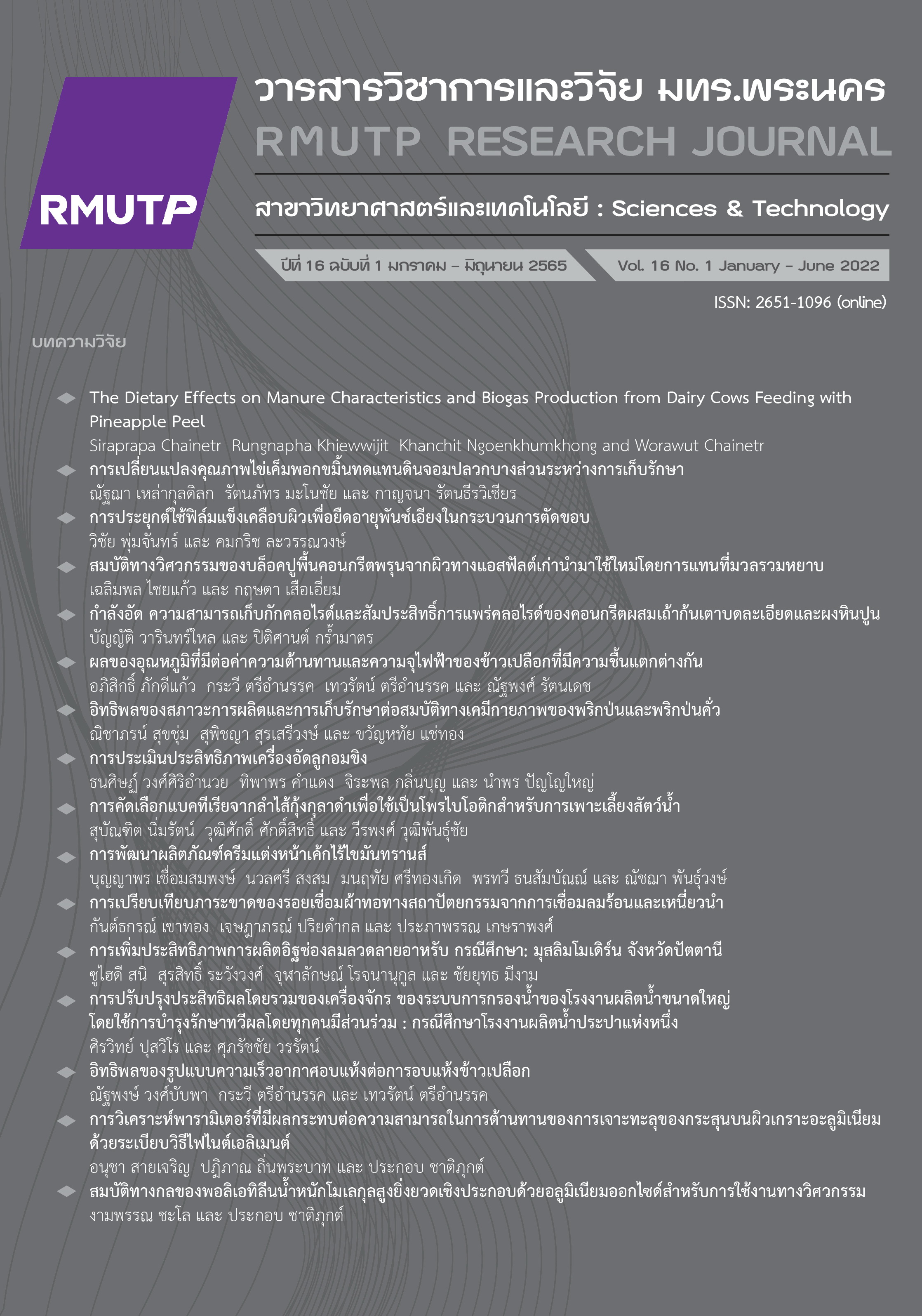Engineering Properties of Porous Concrete Paving Blocks from Recycled Asphalt Pavement as Coarse Aggregate Replacement
Main Article Content
Abstract
This research aimed to study the use of coarse aggregate obtained from removing old recycled asphalt pavement (RAP) in the production of the porous concrete paving block. Crushing and size separation of the coarse aggregate by using standard sieve size by selected the gradation size of the coarse aggregate that passed to sieve size 1/2” and retained on sieve size 3/8” and other that passed to sieve size 3/8” and retained on sieve size No.4 by mixing ratio 50 : 50 of the mass as replaced natural coarse aggregate. Portland cement quantity about 18% and 20% by weight of the aggregate. The water to cement ratio was 0.30 and 0.35 respectively. Compressive strength, flexural strength, and water permeability were investigated. The results showed that the cement content and water to cement ratio was influenced the strength properties and water permeability rate of the porous concrete paving block. The porous concrete paving block mixed with higher cement content (20%) had the compressive strength at the age of 28 days increased by 16-24% when compared with lower cement content (18%). On the other hand, the water permeability rate decreased by 5.1-8.1%.
Article Details

This work is licensed under a Creative Commons Attribution-NonCommercial-NoDerivatives 4.0 International License.
ลิขสิทธ์ ของมหาวิทยาลัยเทคโนโลยีราชมงคลพระนครReferences
N. H. Abd Halim, H. Md. Nor, R. P. Jaya, A. Mohamed, M. H. W. Ibrahim, N. I. Ramli and F. M. Nazri, “Permeability and Strength of Porous Concrete Paving Blocks at Different Sizes Coarse Aggregate,” Journal of Physics: Conference Series, vol. 1049, 2018.
T. Kamon and T. Ronnakorn, “A Study of Water Permeability on Porous Concrete Using Recycled Coarse Aggregates,” in Proceeding of the 25th National Convention on Civil Engineering, Chonburi, Thailand, 2020, pp. MAT13-1-MAT13-7.
C. Nantachai, “Unit Weight and Compressive Strength of Pervious Concrete mixed with Oil Palm Shell,” Journals of Community Development and life Quality, vol. 1, pp. 97-106, 2013.
V. Sata, A. Wongsa and P. Chindaprasirt, “Properties of Pervious Geopolymer Concrete Using Recycled Aggregate,” Construction and Building Materials, vol. 42, pp. 33-39, 2013.
Y. Hirun, T. Tanchaisawat, P. Mulrungsee, V. Bumlungam and A. Peasura, “The Pervious Concrete Paving Blocks,” in Proceeding of the 4th Annual Concrete Conference, Ubon Ratchathani, Thailand, 2008.
A. H. Nur. Hidayah, Md. Nor. Hasanan and P. J. Ramadhansyah, “Porous Concrete Paving Blocks Using Coarse Aggregate,” Applied Mechanics and Materials, vol. 554, pp. 111-115, 2014.
J. Suebsuk, K. Chaiyadechakorn, P. Panpipat and T. Poongernkham, “Compressive and Splitting Tensile Strengths of Concrete Using Recycled Pavement Waste as Coarse Aggregate,” SWU Engineering Journal, vol. 11, no. 2, pp. 125-132, 2016.
J. Suebsuk, K. Chaiyadechakorn and P. Panpipat, “Mix Design of Portland Cement Concrete using Recycled Asphalt Pavement (RAP) as Coarse Aggregate in Highway Applications,” in Proceeding of the 24th National Convention on Civil Engineering, Udonthani, Thailand, 2019.
N. Saboo, A. N. Prasad, M. Sukhija, M. Chaudhary and A. K. Chandrappa, “Effect of the use of recycled asphalt pavement (RAP) aggregates on the performance of pervious paver blocks (PPB),” Construction and Building Materials, vol. 262, pp. 120581, 2020.
Thai Industrial Standard (TIS) 378-2531, Concrete flooring tiles, Thai Industrial Standards Institute, Ministry of Industry, Bangkok, Thailand, 1988.


